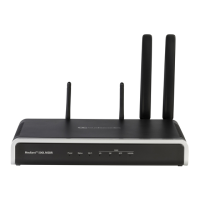User's Manual 410 Document #: LTRT-10466
Mediant 500L MSBR
Parameter Description
Matching Call Characteristics
Web: Src. Trunk Group ID
EMS: Source Trunk Group ID
CLI: src-trunk-group-id
[PREFIX_SrcTrunkGroupID]
Defines the Trunk Group from where the call is received.
To denote any Trunk Group, use the asterisk (*) symbol.
Web: Dest. Phone Prefix
EMS: Destination Phone Prefix
CLI: dst-phone-prefix
[PREFIX_DestinationPrefix]
Defines the prefix and/or suffix of the called (destination)
telephone number. The suffix is enclosed in parenthesis after the
suffix value. You can use special notations for denoting the prefix.
For example, [100-199](100,101,105) denotes a number that
starts with 100 to 199 and ends with 100, 101 or 105. To denote
any prefix, use the asterisk (*) symbol or to denote calls without a
called number, use the $ sign. For a description of available
notations, see ''Dialing Plan Notation for Routing and Manipulation
Tables'' on page 777.
The number can include up to 50 digits.
Notes:
For LDAP-based routing, enter the LDAP query keyword as the
prefix number to denote the IP domain:
"PRIVATE" = Private number
"OCS" = Lync / OCS client number
"PBX" = PBX / IP PBX number
"MOBILE" = Mobile number
"LDAP_ERR" = LDAP query failure
For more information, see Routing Based on LDAP Active
Directory Queries on page 226.
If you want to configure re-routing of ISDN Tel-to-IP calls to fax
destinations, you need to enter the value string "FAX" (case-
sensitive) as the destination phone prefix. For more information
regarding this feature, see the FaxReroutingMode parameter.
Web/EMS: Source Phone Prefix
CLI: src-phone-prefix
[PREFIX_SourcePrefix]
Defines the prefix and/or suffix of the calling (source) telephone
number. You can use special notations for denoting the prefix. For
example, [100-199](100,101,105) denotes a number that starts
with 100 to 199 and ends with 100, 101 or 105. To denote any
prefix, use the asterisk (*) symbol or to denote calls without a
calling number, use the $ sign. For a description of available
notations, see ''Dialing Plan Notation for Routing and Manipulation
Tables'' on page 777.
The number can include up to 50 digits.
Call Setup Rules Set ID
CLI: call-setup-rules-set-id
[PREFIX_CallSetupRulesSetId]
Assigns a Call Setup Rule Set ID to the routing rule. The device
performs the Call Setup rules of this Set ID if the incoming call
matches the characteristics of this routing rule. The device routes
the call to the destination according to the routing rule's configured
action, only after it has performed the Call Setup rules.
For configuring Call Setup rules, see ''Configuring Call Setup
Rules'' on page 256.
Operation (IP Destination)
Web: Dest. IP Address
EMS: Address
CLI: dst-ip-address
[PREFIX_DestAddress]
Defines the IP address (in dotted-decimal notation or FQDN) to
where the call is sent. If an FQDN is used (e.g., domain.com),
DNS resolution is done according to the DNSQueryType
parameter.
The IP address can include the following wildcards:

